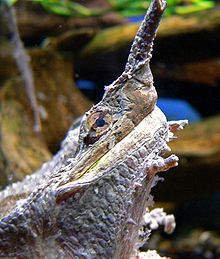Fringed turtle
| Fringed turtle | ||||||||||||
|---|---|---|---|---|---|---|---|---|---|---|---|---|

Fringed Turtle in the Shanghai Aquarium |
||||||||||||
| Systematics | ||||||||||||
|
||||||||||||
| Scientific name | ||||||||||||
| Chelus fimbriata | ||||||||||||
| ( Schneider , 1783) |
The fringed tortoise or Mata-Mata ( Chelus fimbriata ) is a turtle that is up to 40 centimeters tall and lives in freshwater . Their distribution area includes the northern and central Amazon basin in South America . In the southern Amazon region it is only found disjoint on the Rio Xingu and in the northern border area of Bolivia and Brazil in the area of the confluence of the Río Beni and the Río Mamoré in the Rio Madeira .
features
Their back armor ( carapace ) is flat and dark brown. The individual shields of the back armor are domed pyramidal with a point pointing backwards. All of the armored back shields together form three humped longitudinal keels. Every single shield is patterned by radial grooves. The shields of the front edge are slightly curved upwards. The breastplate ( plastron ) is relatively small, from yellowish to brownish color and shows a dark ray pattern.
The head of the fringed tortoise is brownish and completely flat on top. Seen from above, the head, which ends in a thin, snorkel-like trunk at the tip, is triangular, which is reinforced by the fringed skin flaps protruding to the side. The eyes are tiny and sit far in front on the edge of the head. On the underside of the head and the underside of the neck are fringe-like skin flaps, which gave the turtle the common German name. Together the head and neck are almost the length of the armor. The tail, however, is very short. The limbs are short and plump. Between the toes of brownish legs are webbed . The front legs end in five, the hind legs in four sharp claws. Young animals are reddish in color with dark stripes, their back armor is reddish-light brown. The fringed tortoise becomes 40 centimeters long. Overall, its proportions give it an unusual appearance. Due to the skin flaps, it visually blurs with its surroundings and is so well camouflaged.
Way of life
The fringed turtle inhabits slow flowing rivers and streams, ponds and lakes with muddy bottoms. There it lurks, buried in the mud, for prey swimming past, which consists mainly of fish. The prey is sucked in by suddenly opening the very large mouth and the fish is swallowed whole. Apparently the silver color on the flanks and bellies of many fish triggers the snap reflex, because fringed tortoises kept in captivity also swallowed free-floating mercury thermometers , but never those in which red ethanol was used as the thermometric liquid .
Fringed tortoises are very voracious. A captive animal that was 30 centimeters long was observed to eat five to six fish eight to ten centimeters long in a row. However, you can go without food for several days.
Systematics
The fringed tortoise was first scientifically described in 1783 by the German natural scientist Johann Gottlob Theaenus Schneider under the name Testudo fimbriata . In 1806, the French zoologist André Marie Constant Duméril introduced the genus Chelus for the fringed tortoise, which has remained monotypical for more than 200 years . Since the populations of the fringed tortoise in the Orinoco , Rio Negro and Essequibo river basins differ genetically and morphologically strongly from the fringed tortoises native to the Amazon basin, another species of fringed tortoise was described in April 2020. The evolutionary separation of Chelus fimbriata and Chelus orinocensis probably occurred about 12.7 million years ago in the late Miocene . Chelus orinocensis differs from Chelus fimbriata by a more oval carapace (slightly rectangular in C. fimbriata ) and a lighter color. Above all, the belly armor of Chelus orinocensis is light yellow and largely unpigmented, while the belly armor of Chelus fimbriata is dark.
literature
- Gerhard Müller: Turtles. 2nd Edition. Ulmer, Stuttgart 1993, ISBN 3-8001-7258-5 .
Individual evidence
- ↑ Schneider, JG 1783. General natural history of the tortoises, together with a systematic insurance of the individual species. Müller, Leipzig. xlviii + 364 p.
- ↑ Duméril, AMC and G. Bibron. 1835. Erpétologie Générale ou Histoire Naturelle Complète des Reptiles , Vol. 2. Librairie Encyclopédique de Roret, Paris, iv + 680 p.
- ↑ Mario Vargas-Ramírez, Susana Caballerod, Mónica A. Morales-Betancourt, Carlos A. Lasso, Laura Amaya, José Gregorio Martínez, Mariadas Neves Silva Viana, Richard C. Vogt, Izeni Pires, Farias, TomasHrbek, Patrick D. Campbell, Uwe Fritz: Genomic analyzes reveal two species of the matamata (Testudines: Chelidae: Chelus spp.) And clarify their phylogeography. Molecular Phylogenetics and Evolution, April 2020, 106823, doi: 10.1016 / j.ympev.2020.106823

